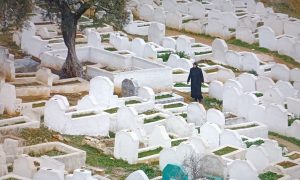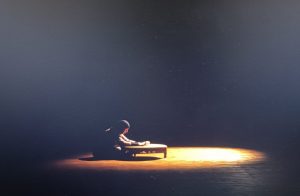Two Faces Connected by a Bridge
We often wonder what we have achieved in our lifetime and whether we were able to add meaning to our journey and make a difference within our community. Such questions arise and become more and more persistent when we find ourselves before a plot twist, as these ruminations about the righteousness of our choices become our existential strife.
Within our struggle, we find ourselves standing still along a path, pondering: shall we proceed in the same direction, or shall we take a step backwards and alter our course? What if these speculations revolved around the sentiments of a woman torn between two cultures and two religions? Furthermore, what if that woman was a mother who lost her son when he blew himself up in a terrorist operation?
It is precisely within this circle that the documentary film After the Bridge (64 min, 2023) by its directors Davide Rizzo & Marzia Toscano revolves.

Two affiliations, Two identities, and Two names
The Italian Valeria Collina comes from a Catholic family. She meets a Moroccan Muslim guy younger than she. His personality reminds her of the resistance of her father, Rafaello, whom she immensely admires, and from whom she preserves the meanings of justice, honor, and loyalty. Fascinated by the African continent, she moves with Muhammad after marriage in Morocco. This new situation requires her to change her name (to Khadija), her religion and dress, and forget about her hobbies, especially acting for the theater.
Valeria gives birth to a daughter and a son named Youssef, learns lessons in the Qur’an, and establishes a home and family. Nevertheless, two things turn her life upside down and leave her stranded before a crossroads. One is Muhammad’s marriage to a second woman, which pushes Valeria to leave Morocco and return to Italy. Additionally and foremost is her son Youssef’s participation in a suicide bombing on London Bridge (June 3, 2017).
The Cat and Its Kittens
The scene of a cat and its kittens is not in the intro of the film, but rather in later shots, as though to convey other meaning and usage. Valeria, who is in her sixties, lives alone with her cat, her books, her pictures—the pictures of her Italian and Moroccan families—with her past, and with her disappointments. Valeria recalls enjoying a happy childhood, and her childhood pictures most definitely depict that. She remembers her past vividly, as she draws out comparisons between what she was and what she has become; and as a churchman makes her watch a video of a radical Iraqi Muslim reciting a speech before blowing himself up, Valeria can’t help but contemplate the idea of fighting for divine glory, and seeking this glory by killing anyone who is different!
After the incident of the bridge, Valeria begins doubting her choices, wondering about her responsibility as a mother, and as the image of the cat with her kittens comes to her mind, she can’t help but wonder whether her child-raising methods played a role in shaping Youssef’s fate. She recalls Youssef powerlessly witnessing her defenselessly enduring domestic violence just to sustain the unity of her family. In her last call with him from London, he revealed his desire in marrying “Hoor al-Ayn” (the woman promised to martyrs in Paradise according to the religious scripts in Islam). Valeria’s surprise at that revelation was great, and her fear was even greater!

This body… Heavy on the Sofa, Graceful on the Stage
This incident leaves an unhealable wound within her which pushes her to restore her Italian name. It also prompts her to remember her previous lifestyle, who she was, what she loved, and what she had fruitlessly tried to forget a long time back. Not only does she restore her place and name, but she also regains her relationship with her body. Nevertheless, that isn’t without inner struggle as questions are raised in her mind regarding the rigorousness of Islam, especially in the matter of women covering up their bodies. As she suffers from the loneliness and the weight of her painful memories, she decides to work on regaining the flexibility of her vocal cords, her physical fitness, as she rejuvenates her passion for acting.
From here, Valeria can be seen at home taking yoga lessons, memorizing a role she wrote, and rehearsing to perform it on stage. The role tells the story of the sofa, with its multiple uses and transformations: from a seat for sitting and resting, to a place for eating, and for sleeping. What Valeria tries to display is her desire to completely identify with the movement of the sofa, and to be as changeable, shifting, and dynamic as it. Remembering that her first meeting with Muhammad took place when she was performing an acting role on a stage, prompting her to choose a rebirth for her body, revealing her hair without a veil.
The Aesthetics of Disappointment
Within sixty-four minutes, the directors of After the Bridge are able to unveil the central character, Valeria, the camera shedding light upon her face and movements in close-up and distant shots, following her path in resisting sadness, evaluating and reconsidering the choices she made throughout her life. In this sense, the visual language is poetically presented as it reflects a subjective experience. Nevertheless, despite its subjectivity, Valeria’s experience sows uncertainty in the hearts of its viewers as it projects this doubt upon their own experiences.
Here upon, if cinema is a celebration of life, then theater is life in miniature, as life itself is a theater. Given that Valeria is an actress, it is not surprising that many scenes in the film were staged, and that the film displays an old theatrical clip of her, before she crossed the cultural bridge to Africa, and other scenes of her acting attempts after the bridge. From here, After the Bridge exhibits two meanings: the realistic one of the terrorist bombing that occurred over London Bridge, and the metaphorical one of Valeria’s emotional and temporal crossing from the past towards a different future. In this essence, the film dynamically presents us with a drama that blends reality with individuality, combining imaginative construction and documentation.
Conceivably, art has a salvific and a healing role, and this is exactly what Valeria reveals in the film, which beautifully displays the story of her suffering in an expressive cinematic language. The camera moves between minimalist shots of Valeria’s face, her body, and journey, to panoramic views of the forest, the river, her family’s cemetery, the Italian city of Bologna, the sea, and the city of Fez, on the other side of Morocco as well as to the cemeteries where Valeria prays her Islamic prayer and recites a surah from the Qur’an. All of these scenes match the main theme of the film, hence adding up to its realistic perspective and not merely recording the events.
As a whole, the film comprises audio recordings of Valeria alongside her call with Youssef before the bombing, interviews conducted with her by numerous channels and newspapers, as well as the documentary recording of the bombing incident and prayers for its victims. Moreover, it incorporates dialogues, personal narratives, and soundtracks, utilizing the technique of silent scenes to provoke contemplation of Valeria’s expression of different emotional states. The film also relies on video clips that depict the beauty of her life, and photos of Youssef that Valeria keeps in remembrance of his innocent face. From here, the film displays all of these scenes as if to highlight that this past exists in pictures, and that the memory only recalls it in order to be liberated from its pain, the pain of being labeled the “mother of the terrorist,” and to overcome it in hope for a brighter tomorrow.
Soumaya Azzam
Edited by Robert Horton
© FIPRESCI 2024
